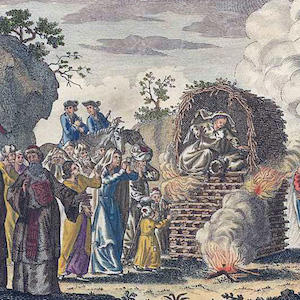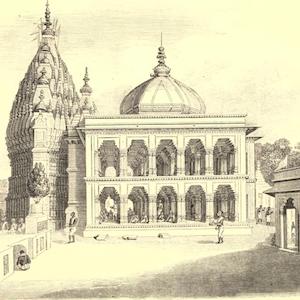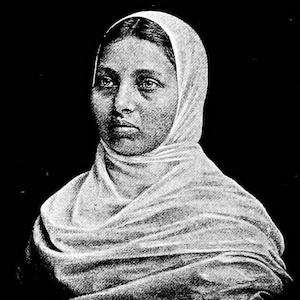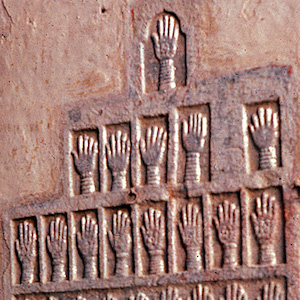Long Teaching Module: Sati
Overview
The status of widows in many societies has been precarious, because the deaths of husbands removed the primary source of their economic well-being as well as control over their sexuality. If there were no adult sons to support widowed mothers, other kinfolk might be reluctant or lack the means to care for widowed relatives. Many societies where men held dominant power evolved mechanisms to control the social and sexual relationships of widows. The burning or burying of widows with their deceased husbands occurred at various times in places as diverse as central Asia, South and Southeast Asia, and Fiji. While Sati did occur, it is important for students to understand this topic in its historical and cultural context and not only focus on aspects of South Asian historical practices perceived to be exotic.
This long teaching module includes an informational essay, objectives, activities, discussion questions, guidance on engaging with the sources, and essay prompts relating to the twelve primary sources.
Essay
Sati in India
In India, the Laws of Manu, compiled around 200 CE declared that a Hindu widow was to remain sati, a Sanskrit word that was interpreted to mean chaste or pure, and was not to remarry, while a Hindu widower was permitted to marry again. Gradually, the word sati was used to designate the ritual of self-immolation or self-sacrifice by a Hindu widow on her husband’s pyre. Through her self-sacrifice, a widow remained pure and demonstrated her everlasting devotion to her husband. Thus sati (a word that Europeans frequently transliterated as suttee) came to mean both the practice of self-immolation and the Hindu widow who died by this ritual. Such a widow was thought to become a goddess and to bring auspiciousness or good fortune to her birth and marital families. Her cremation site was also marked by a commemorative stone or temple and became a pilgrimage site for devotees seeking divine favors. It is important to keep in mind that the sati as self-immolation was never widespread and the practice was condemned by many Indians at the time particularly by Mughal officials and those in the Sikh community. The practice became and remains a potent source for stereotypes of Indian society as ridden with exotic and superstitious religious injunctions. Western feminists have also historically employed the Sati narrative to portray Hindu women as oppressed and without agency.
The Origins of Sati
The origins of sati as self-immolation are hotly debated. It is often associated with war and concepts of honor. One possible source was the deaths of four widows in the Mahabharata, a great epic about a war between two sets of cousins for a kingdom. Another is the custom of jauhar among Rajputs, groups from central Asia who migrated to northwestern India, who, when confronted with certain defeat, put their women and children to death by fire to prevent their enemy from capturing and dishonoring them. One religious source mentioned is the Hindu goddess named Sati who committed suicide in protest against her father’s refusal to invite her divine husband Shiva to a royal sacrifice. But Sati died and the god Shiva was incapable of dying, so she was not and could not be a widow.
There is much debate about when the practice of self-immolation began to be practiced in India. Some historians claim that there is material evidence in the form of commemorative stones of self-immolation as early as the 6th century CE and European accounts of the sati ritual begin with Marco Polo and proliferate from the 1500s onward. Sati stones exist in the Gujarat and Marathi areas of western India and in Karnataka and the eastern coast of south India. However, self-immolation was more prevalent among elite women in the princely states of Rajputana and in Bengal. Some scholars have argued that the dayabhaga legal tradition that was unique to Bengal, which allowed Hindu widows to inherit their stridhan (personal property, usually jewelry given at the time of her marriage) and a limited estate in real property (which they could use but not alienate), was perhaps a material reason why sati was more common in Bengal than elsewhere. Anand Yang, however, has documented that non-elite Hindu widows committed sati in the early 19th century in districts in Bihar and Bengal, where women’s property rights were not likely to be at stake. The social restrictions on Hindu widows that might include shaving one’s hair, discarding all jewelry, and wearing simple white saris, eating only one meal a day, and being excluded from celebrations such as weddings constituted “cold” sati and could have motivated some widows to willingly commit self-immolation.
European Views of Sati
As more Europeans traveled to India from the 1500s onward to forge trade and diplomatic relations, they recorded their observations and attitudes towards sati and the Hindu culture that they asserted authorized such deaths. Their accounts tended to praise the devotion of Hindu wives to their husbands and to emphasize the religious injunctions for the ritual. As it expanded its political control during the 18th century, the English East India Company viewed sati as a disturbing religious practice but permitted it so as not to antagonize Hindu subjects. By the early 1800s, British officials and missionaries became more aggressive in their condemnation of sati, although their accounts continued to have subtle praise for the wifely devotion of Hindu widows. At the same time high-caste Hindus, frequently of the bhadralok (respectable people) elite in Bengal, either defended the ritual or sought to prohibit it.
The debate over sati escalated when the East India Company, under pressure from evangelical groups in Britain, legalized sati in 1813 if the widow acted voluntarily. This legislation triggered intense debate in India and Britain both for and against sati. British missionaries as well as Indian advocates and opponents of sati sought sanction for their opposing positions in Hindu scriptural texts. Emboldened by support from Indians such as Ram Mohan Roy and influenced by the Utilitarian philosophy which sought the greatest good for the greatest number of people through legislation, Lord William Bentinck, governor-general of the Company’s possessions in India from 1828 to 1835, promulgated legislation criminalizing sati in 1829. Controversy persisted during the 1830s because of continuing episodes of sati. It proved difficult to enforce the prohibition in a climate where cremation took place usually within 24 hours of death and British officials were widely dispersed. Contention resurfaced in the late 20th century after Roop Kanwar, an 18-year-old Rajput woman, allegedly committed sati at Deorala, Rajasthan, on September 4, 1987 in very different political and social circumstances.
Sources About Sati
European travelers, British officials, Indian reformers, orthodox Hindus, and Christian missionaries wrote extensively about sati, while Europeans and Indians produced visual representations in prints, paintings, magazines, and eventually, films. Men produced almost all of these primary sources that contained several themes. First, Indians and Europeans debated the origins of sati, traced where it occurred in India, and occasionally tried to ascertain which varnas (the four broad divisions of Hindu society: brahman, or priests; kshatriya, or warriors and administrators; vaishya, or merchants; and sudras, or artisans and peasants) and economic classes enjoined the practice of sati on Hindu widows. Second, both orthodox Hindus and those seeking to reform Hindu customs argued about the scriptural legitimacy, or lack thereof, for sati. Third, European travelers, officials, and missionaries revealed much about their changing attitudes toward Indian culture and specifically to Indian women in their accounts of sati from the 1600s onward. Fourth, during the early 1800s, the campaign to prohibit sati produced official reports and polemical tracts that gave evidence of cultural arrogance among British officials and missionaries, defensiveness among Indian reformers, and assertiveness among orthodox Hindus.
Sources in English or available in English translation have told us more about European representations of and attitudes toward the ritual of sati, European ideas about Indian (specifically Hindu) women, and about Hindu culture in India in general than about Indian attitudes toward sati. Even so, the positions of Indian men regarding sati are much more accessible in primary sources than those of Indian women. For the stories of Hindu widows who committed self-immolation or attempted to do so and decided against doing so at the last minute, historians must rely on British and Indian, usually male, witnesses of the spectacle of sati.
Primary Sources
Teaching Strategies
This section provides primary sources that document how Indian and European men and one English and one Indian woman have described the practice of sati, or the self-immolation of Hindu widows.
Although they are all critical of self-immolation, Francois Bernier, Fanny Parks, Lord William Bentinck, and Rev. England present four different European perspectives on the practice of sati and what it represents about Indian culture in general, and the Hindu religion and Hindu women in particular. They also indicate increasing negativism in European attitudes toward India and the Hindu religion in general. It would be useful to compare the attitudes of Bentinck and England as representing the secular and sacred aspects of British criticism of sati. A comparison of Bentinck’s minute with the subsequent legislation also reveals differences in tone between private and public documents of colonial officials. Finally, a comparison between the Fanny Parks and the three men should raise discussion on whether or not the gender and social status of the writer made any difference in his or her appraisal of the practice of self-immolation.
The four sources by Indian men and one by an Indian woman illustrate the diversity of their attitudes toward sati. The painting by Mohammad Rizā Naw'ī demonstrates how Sati was viewed negatively by the Muslim Mughal rulers of India. The Marathi source illuminates the material concerns of relatives of the Hindu widow who is urged to adopt a son, so as to keep a potentially lucrative office within the extended family. These men are willing to undertake intense and delicate negotiations to secure a suitably related male child who could be adopted. This letter also documents that adoption was a legitimate practice among Hindus, and that Hindu women as well as men could adopt an heir. Ram Mohan Roy’s argument illustrates a rationalist effort to reform Hindu customs with the assistance of British legislation. Roy illustrates one of the many ways in which Indians collaborate with British political power in order to secure change within Indian society. He also enabled the British to counter the arguments of orthodox Hindus about the scriptural basis for the legitimacy of self-immolation of Hindu widows. The petition of the orthodox Hindu community in Calcutta, the capital of the Company’s territories in India, documents an early effort of Indians to keep the British colonial power from legislating on matters pertaining to the private sphere of Indian family life. Finally, Pandita Ramabai reflects the ways in which ancient Hindu scriptures and their interpretation continued to dominate debate. Students should consider how Ramabai’s effort to raise funds for her future work among child widows in India might have influenced her discussion of sati.
Two key issues should be emphasized. First, both Indian supporters and European and Indian opponents of the practice of self-immolation argue their positions on the bodies of Hindu women, and all the men involved appeal to Hindu scriptures to legitimate their support or opposition. Second, the voices of Indian women were filtered through the sieve of Indian and European men and a very few British women until the late 19th century.
Discussion Questions:
- How do the written and visual sources portray the Hindu women who commit self-immolation? Possible aspects range from physical appearance and age, motivation, evidence of physical pain (that even the most devoted woman must suffer while burning to death), to any evidence of the agency or autonomy of the Hindu widow in deciding to commit sati. Are any differences discernible, and if so, do they seem related to gender or nationality of the observer or time period in which they were observed?
- How are the brahman priests who preside at the self-immolation portrayed in Indian and European sources? What might account for any similarities and differences?
- What reasons are used to deter Hindu widows from committing sati? What do these reasons reveal about the nature of family life in India and the relationships between men and women?
- What do the reasons that orthodox Hindus provide to European observers and to Indian reformers reveal about the significance of sati for the practice of the Hindu religion? What do their arguments reveal about orthodox Hindu attitudes toward women and the family?
- How are Hindu scriptures used in various ways in the debates before and after the prohibition of sati?
- What is the tone of the petition from 800 Hindus to their British governor? Whom do they claim to represent? What is their justification for the ritual of self-immolation? What is their attitude toward the Mughal empire whose Muslim rulers had preceded the British? What is their characterization of the petitioners toward those Hindus who support the prohibition on sati? How do the petitioners envision the proper relationship between the state and the practice of religion among its subjects?
- Who or what factors do European observers, British officials, and Indian opponents of sati hold to be responsible for the continuance of the practice of sati?
- What were the reasons that widows gave for committing sati? Were they religious, social or material motives? What is the evidence that the widows were voluntarily committing sati before 1829? What reasons did the opponents of sati give for the decisions of widows to commit self-immolation? What reasons did opponents give for widows who tried to escape from their husbands’ pyres?
- What are the reasons that Lord Bentinck and his Executive Council cite for their decision to declare the practice of sati illegal? Are the arguments similar to or different from his arguments in his minute a month earlier? What do these reasons reveal about British attitudes toward their role or mission in India? Do they use any of the arguments cited by Ram Mohan Roy or Pandita Ramabai?
- What do these sources, both those who oppose sati and those who advocate it, reveal about their attitudes to the Hindu religion in particular and Indian culture in general?
Lesson Plan
Perceptions of Sati: A Comparative Analysis
Time Estimate
Five 50-minute class periods and DBQ as an independent assignment.
Objectives
After completing this lesson, students will be able to:
- analyze textual primary sources.
- analyze visual primary sources.
- recognize the ways that language reveals point-of-view.
- analyze how the cultural biases of Europeans and Indians influence their attitudes toward the act of sati.
Materials
- The introduction in the Overview on this page
- The following sources found in the Primary Sources folder on this page (European viewpoint):
- Source 2: Letter, Francois Bernier
- Source 6: Diary, Fanny Parks
- Source 9: Engraving, James Peggs
- Source 10: Nonfiction, James Peggs
- The following sources found in the Primary Sources folder on this page (Indian viewpoint):
- Source 1: Painting by Mohammad Rizā Naw'ī
- Source 5: Nonfiction, Rajah Rammohun Roy
- Source 8: Petition, Orthodox Hindus
- Source 10: Nonfiction, Pandita Ramabai
- Source 11: Object, Sati Handprints
- Sufficient copies of Primary Source Analysis Worksheet: Images
- Sufficient copies of Primary Source Analysis Worksheet: Texts
Strategies
- Hook:
- Ask students to respond on paper to the following question: “What traditions does your family engage in that other families might think are strange or unusual?”
- After students have written down their individual answers, have them share them with the class.
- Write the words “cultural bias” on the board and give students the definition: cultural bias is when we judge others according to the standards or norms of our own culture. Lead a discussion linking that definition back to the examples they shared.
- Contextualizing the Sources:
- Direct students to read the Overview on this page
- After they have read the selection, have students answer the following questions on paper, then discuss as a class:
- Define what the word “sati” refers to today.
- What is the literal translation of the word in Sanskrit? Why might that word have been chosen to refer to the self-immolation ritual of widows?
- What other restrictions have historically been put on widows?
- Why might widows as a social group have had restrictions put on them? What about them makes them vulnerable? What about them makes them a possible threat to society?
- Create a chronology of European views of sati.
- How did European views of sati change over time?
- Interpreting the Sources:
- Direct students to read each of the primary sources, being sure to keep the European sources separate from the Indian sources.
- Distribute Primary Source Analysis Worksheet: Images and Primary Source Analysis Worksheet: Texts.
- Direct students to fill out the worksheets for each of the eight assigned sources. They should complete this individually, either for homework or in class.
- Discuss their responses as a class.
- Comparing Points-of-View:
- Have students go back through the textual sources and circle words used to characterize: the widows, the Brahmins, and the act of sati. Remind them to keep the sources written by Europeans separate from the sources written by Indians.
- Divide students into small groups, then ask them to create charts of the words they circled in the documents. They must create two separate charts: the first will list words used by Europeans to describe widows, Brahmins, and sati. The second chart will list words used by Indians to describe widows, Brahmins, and sati.
- Instruct students to use their charts to answer the questions below, continuing to work in small groups.
- How would you characterize the language used by Europeans to describe the widows? The Brahmins? The act of sati?
- Students should understand that the Europeans tend to describe the widows as victims, the Brahmins as perpetrators of evil, and the act of sati as a strange, barbaric ritual. Be sure to link these characterizations back to the concept of cultural bias.
- How would you characterize the language used by Indians to describe the widows? The Brahmins? The act of sati?
- Students should see that the language used by Indians allows for more agency on the part of widows. Widows are seen as having a variety of motives for engaging in the act of sati and having some control over the act itself. Brahmins are characterized in multiple ways but are generally not demonized. The act itself is described in more neutral language than the Europeans used. In general, Indians do less stereotyping and generalizing about the act and its participants.
- Discuss their answers as a class.
- Conclude by discussing why European and Indian perceptions may have differed and what motives the Europeans and the Indians may have had for using the language they did.
- Students should again connect European and Indian perceptions with the concept of cultural bias. Because the Indians are familiar with sati and see it as part of their cultural standard, their characterizations of it are more complex. Indians are also less likely to characterize women as being victims than are Europeans. Both sides use inflammatory language to try to persuade their audiences to support their argument.
- Document-Based Essay Question:
- Distribute copies of the Document-Based Essay Question.
- Allow students time in class to brainstorm and outline their ideas.
- Instruct students to complete the essay outside of class. Collect in the next class period.
Differentiation
Technology:
- Teachers in classrooms with SMART Boards, student laptops, and access to SMART programs may wish to integrate their technology into the “comparing points-of-view” portion of the lesson. After students circle the language choices made by the Europeans and the Indians, divide them into groups, giving one laptop to each group. Instruct students to use the laptops to create two concept maps in SMART Ideas, one mapping the words used in the European sources, and one mapping the words used in the Indian sources. Then, have the groups email their concept maps to the teacher. Choose the best ones, display them on the SMART Board, and use them as a model for the class discussion about how to characterize the language choices found in both sets of sources.
Advanced Students:
- As a hook, ask students what rituals they can think of that involve the use of fire. Brainstorm a list as a class, then ask students to write down any themes that they see. One theme should be the association of fire with purification or chasteness. Discuss why this is true. Bring this theme up again at the end of the “Comparing Points of View” section of the lesson by asking students to compare European and Indian uses of fire and concepts of what it means to be pure.
- In the “Interpreting Sources” step, only have students fill out a complete worksheet for visual image and one textual source. Rather than filling out the rest of the worksheets alone, then discussing them, accelerate the lesson by having students fill them out as you discuss the documents.
- Instruct students to complete the Document-Based Essay at home; do not allow for extra in-class time to complete outlines and do brainstorming around the question.
Less Advanced Students:
- Complete more steps of the lesson as a class rather than asking students to complete them individually. This is particularly necessary for the document interpretations: read the documents out loud as a class, then complete the text worksheets as a class.
- Add an intermediate step in creating the document-based essay: ask students to hand in an outline of their answer, receive feedback from you, then turn the outline into an essay.
Document Based Question
Document Based Question (Suggested writing time: 40 minutes)
Directions: The following question is based on the documents included in this module. This question is designed to test your ability to work with and understand historical documents. Write an essay that:
- Has a relevant thesis and supports that thesis with evidence from the documents.
- Uses all or all but one of the documents.
- Analyzes the documents by grouping them in as many appropriate ways as possible. Does not simply summarize the documents individually.
- Takes into account both the sources of the documents and the authors' points of view.
You may refer to relevant historical information not mentioned in the documents.
Question: Significant differences exist between the European and Indian attitudes toward the act of sati and toward the participants in that act. Account for why those differences exist.
Be sure to analyze point of view in at least three documents or images.
What additional sources, types of documents, or information would you need to have a more complete view of this topic?
Bibliography
Credits
About the Author
Barbara Ramusack is Professor of South Asian and Chinese History at the University of Cincinnati. She is the author of The Indian Princes and their States, coauthor of Women in Asia: Restoring Women to History, and has written numerous articles and essays on women in India during the late colonial period. Her research has been recognized and supported by the American Institute for Indian Studies, the Charles Phelps Taft Fund, the Smithsonian Institution, the U.S. Department of State Fulbright Program and the National Endowment for the Humanities. For the 2020 transfer of this module to World History Commons, additional background and contextual information was provided by Carolien Stolte, an Assistant Professor of History at the Institute for History, Leiden University (Netherlands)
About the Lesson Plan Author
Janelle Collett is a history teacher and faculty technology leader at Springside School in Philadelphia, PA.
This teaching module was originally developed for the Women in World History project.








